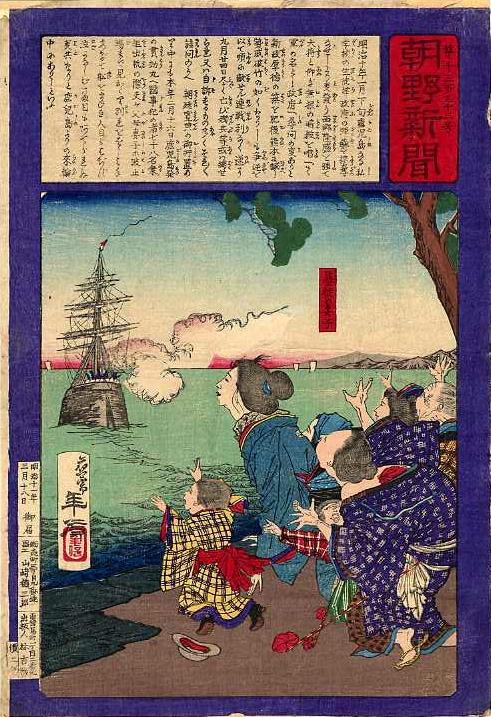Kwanko Maru
Kwanko Maru, the name of the ship, reflects the "w-glide" that differentiated "ka/ga" and "kwa/gwa" Sino-Japanese terms. Today, "kwa/gwa" terms are generally pronounced and written "ka/ga" but present-day kana orthography still accommodates w-glides, and w-glides continue to characterize the romanizations of a few words and organizational names.
Of interest here is whether the name of the ship was "Kwanko Maru" at the time of the incident, or whether the story writer is using the name of the ship that may have been given the name later that year.
According to Nagasawa Fumio's Natsukashii Nihon no kisen (なつかしい日本の汽船) <Nostalgic Japanese Steamships, Fumio Nagasawa>, the Kwanko Maru, with a displacement of 185 gross tons, was built in London in 1869 and sold to Tsushima province in 1870, at which point it was known as the Sakana. The following year it was transferred to the Japanese government, then in April 1877 -- during the Seinan War -- it was sold to the Mitsubishi Mail Steamship Company, after which it was renamed Kwanko Maru. The vessel was struck from the register of ships in 1918, nearly half a century after it was built. It spent the last two decades of its life under the ownership of a series of owners based in Hakodate.
Nagasawa's data base shows the following history.
Nagasawa Nagasawa Fumio's "Natsukashii Nihon no kisen" (なつかしい日本の汽船) (Nostalgic Japanese Steamships, Fumio Nagasawa) shows the following history of the Kwanko Maru, according to which the ship was built as the "Sakana" in London in 1869, renamed "Kwanko Maru" sometime after it was sold to the Mitsubishi Steamship Company in April 1977, and struck from the register of ships in 1918.
貫効丸 KWANKO MARU (1869)
496/HDGJ 185G/T 進水 1869(明2)
Lpp 41.70 B 6.25 D 5.12 m 66/150PS 9.5kt
Henderson Coublorn & Co.,Renfrew建造 E. M. De Bussche,London
SAKANA
1870 (明3) 対馬藩に売却
1871 (明4) 日本政府に移管
1877.4 (明10) 郵便汽船三菱(東京)に売却後、貫効丸 KWANKO MARU と改名(時期不詳)
1885.10.1 (明18) 日本郵船(東京)に移籍
1898.9.12 (明31) 酒沢岸太郎(函館)に売却
1908 (明41) 相馬市作(函館)に売却
1912 (明45) 讃岐新吉(函館)に売却
1918 (大7) 船名録から削除
Other lists classify the ship as "kihan" (機帆) or "mechanized (motorized) sail" boat, as it is depicted on Toshinobu's Chōya shinbun print.
Toshinobu
As his name suggests, the drawer, Toshinobu (年信 1857-1886), was a student of Yoshitoshi (芳年 1839-1892). As noted in the publishing particulars shown in the lower right margin, he was legally Yamazaki Tokusaburō (山崎徳三郎). See Toshinobu on the "Who's who" page in the "Almanac" section for details.
Print information
Series: Chōya shinbun
Number: 1353b
Date: Meiji 11-3-18 (1878-3-18) (otodoke)
Publisher: Hayashi Kichizō (林吉蔵)
Drawer: Yamazaki Toshinobu (Yamazaki Tokusaburō)
Carver: Unstated
Writer: Unstated
Size: Ōban
Image: Yosha Bunko
